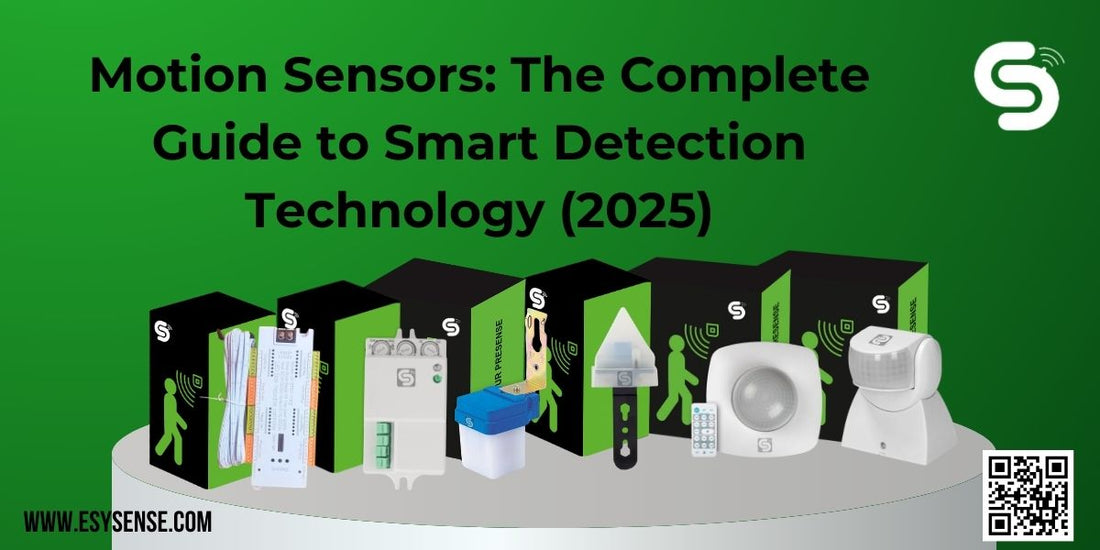
Motion Sensors: The Complete Guide to Smart Detection Technology (2025)
Motion Sensors: The Complete Guide to Smart Detection Technology (2025)
Motion sensors have revolutionized home security and automation, offering convenience, energy efficiency, and enhanced safety. In this comprehensive guide, we'll explore everything you need to know about motion sensor technology, from basic functionality to advanced applications in modern smart homes.
What Is a Motion Sensor?
A motion sensor is an electronic device that detects movement within its coverage area. When movement is detected, these devices can trigger various responses, such as activating lights, security systems, or sending notifications to your smartphone.
Types of Motion Sensors
1. Passive Infrared (PIR) Sensors
- Most common type in residential applications
- Detects body heat and movement
- Energy-efficient and cost-effective
- Ideal for indoor and outdoor lighting systems
2. Microwave Sensors
- Emits microwave radiation to detect movement
- Covers larger areas than PIR sensors
- More expensive but highly accurate
- Less affected by temperature changes
3. Dual Technology Sensors
- Combines PIR and microwave technologies
- Reduces false alarms
- Provides more reliable detection
- Ideal for high-security applications
Click here for more information : Motion sensor Light
Key Applications
Home Security
- Intrusion detection
- Automated surveillance
- Security camera activation
- Emergency lighting
Smart Lighting
- Automatic light control
- Energy conservation
- Pathway illumination
- Garage and entryway lighting
Energy Management
- HVAC system optimization
- Occupancy-based climate control
- Automated ventilation
- Smart thermostat integration
Installation Tips
Optimal Placement
1. Mount sensors at appropriate heights (typically 6-8 feet)
2. Avoid direct sunlight exposure
3. Keep away from heating/cooling vents
4. Consider pet movement patterns
Smart Home Integration
Automation Possibilities
- Custom lighting scenes
- Security system coordination
- Climate control automation
- Smart device triggering
Energy Efficiency Benefits
Cost Savings
- Reduces unnecessary lighting usage
- Optimizes HVAC operation
- Lowers electricity bills
- Extends bulb lifespan
Environmental Impact
- Decreases energy waste
- Reduces carbon footprint
- Supports sustainable living
- Promotes green technology
Troubleshooting Common Issues
False Triggers
- Adjust sensitivity settings
- Clean sensor lenses regularly
- Update firmware if applicable
- Check for interference sources
Buying Guide
Key Considerations
1. Coverage area needs
2. Indoor vs outdoor use
3. Power source requirements
4. Smart home compatibility
5. Budget constraints
Top Features to Look For
- Weather resistance (for outdoor units)
- Adjustable sensitivity
- Remote control capabilities
- Battery backup options
- Warranty coverage
Future of Motion Sensor Technology
Emerging Trends
- AI-powered detection
- Enhanced smartphone integration
- Improved energy efficiency
- Advanced security features
Innovation Areas
- Facial recognition capabilities
- Gesture control integration
- Environmental adaptation
- Enhanced range and accuracy
Conclusion
Motion sensors represent a cornerstone of modern home automation and security. Whether you're looking to enhance your home's security, improve energy efficiency, or simply add convenience to your daily life, understanding motion sensor technology is essential. By choosing the right type and implementing it correctly, you can create a smarter, safer, and more efficient living space.
FAQs
1. How long do motion sensors typically last?
- Quality motion sensors can last 5-10 years with proper maintenance.
2. Can pets trigger motion sensors?
- Many modern sensors offer pet immunity up to certain weights (typically 40-80 lbs).
3. Do motion sensors work through walls?
- Most standard motion sensors cannot detect movement through solid walls.
4. What's the difference between indoor and outdoor motion sensors?
- Outdoor sensors are weatherproof and typically have different sensitivity settings.
5. Can motion sensors be hacked?
- While possible, most modern sensors include security features to prevent unauthorized access.
